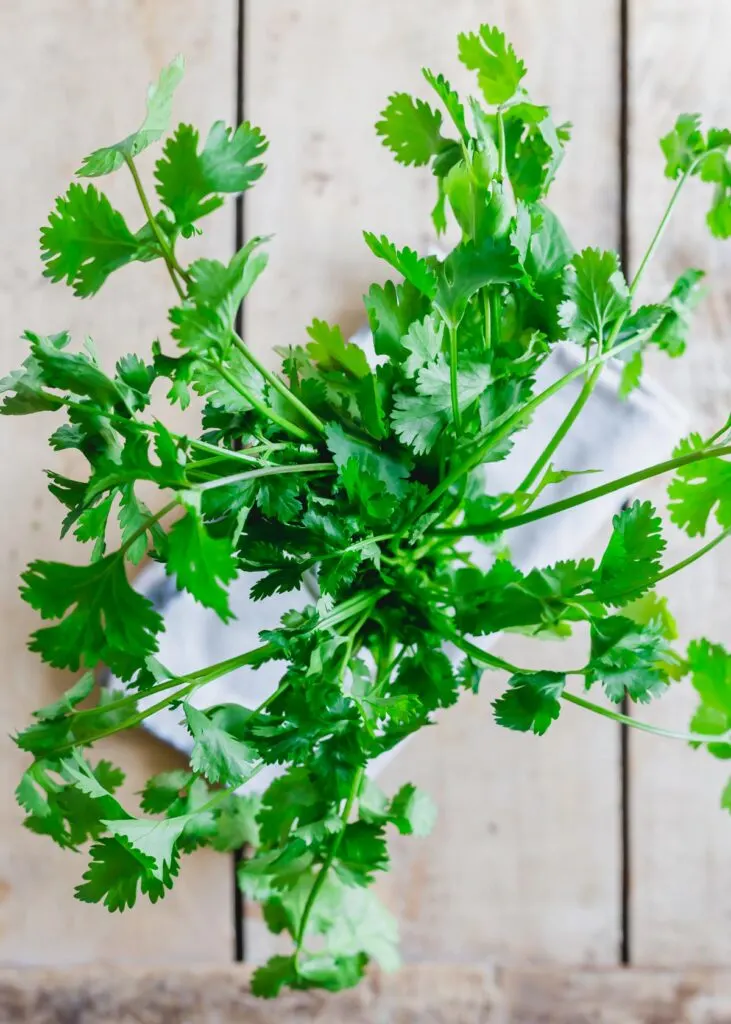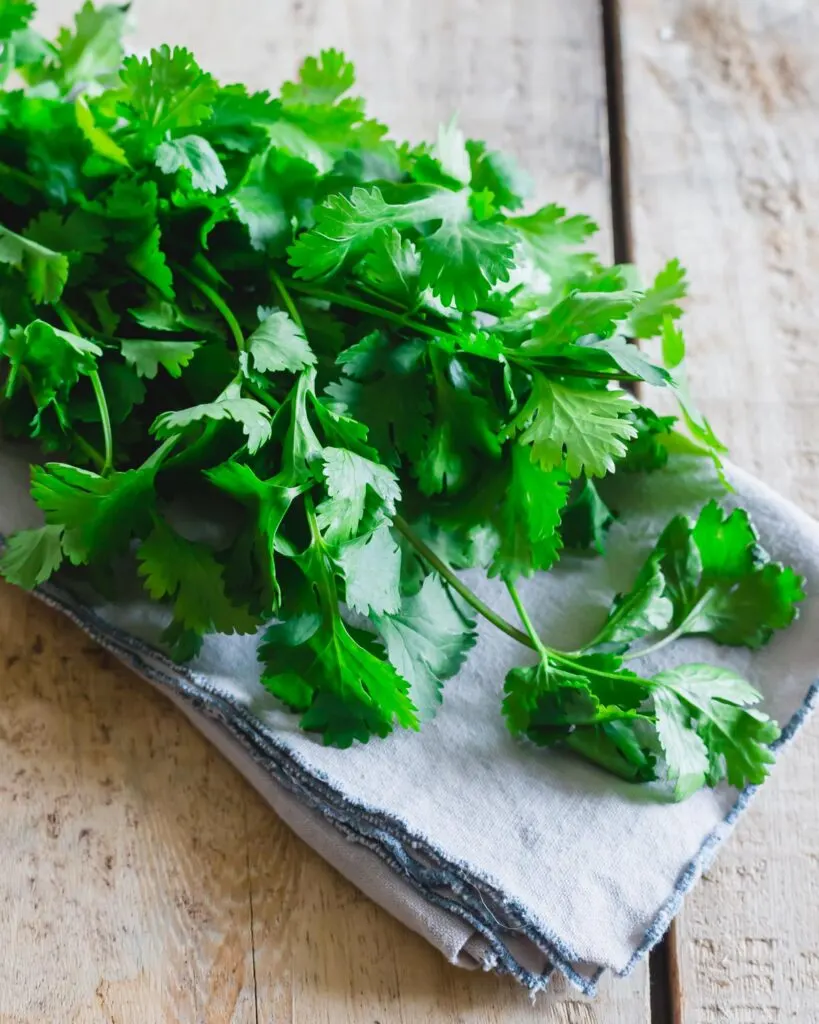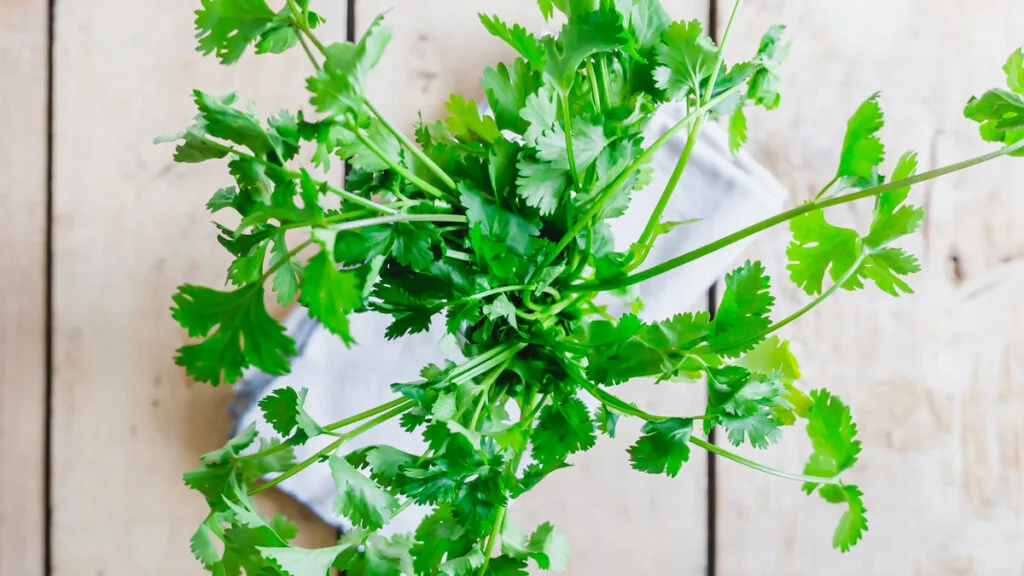Cooking with fresh herbs is common practice to make human food taste better. So, you may be wondering if it’s also safe for your dog to enjoy this flavorful herb from time to time?
The good news is, like basil, dogs can eat cilantro – in fact, it can actually be a healthy addition to their diet when incorporated appropriately.

WHAT IS CILANTRO?
Cilantro (sometimes called Chinese or Mexican parsley) is a popular herb used in many cuisines. Cilantro actually refers to the leaves from the coriander plant (Coriandrum sativum) which is part of the parsley family.
Coriander seeds (the seeds from the cilantro plant) are dried to create coriander spice.
While it’s from the same plant, the dried spice and fresh leaves have different tastes and we’re focusing primarily on the fresh leaves in this article
The taste of cilantro can actually be quite polarizing for humans as some describe it being similar to soap whereas others love the bright, refreshing and lemony nature of this herb.
Do some dogs have this same opinion of cilantro? We may never know!
HEALTH BENEFITS OF CILANTRO
Not only is cilantro safe for your dog to eat, it can actually be a healthy supplement to your dog’s diet and overall health!
This isn’t the case for all herbs. In fact, its important to know the difference of the many culinary herbs out there when it comes to feeding dogs. For example rosemary and lavender have very different effects on a dog’s health.
Let’s explore all the potential benefits of cilantro.
CILANTRO FOR DIGESTIVE BENEFITS
Since ancient times cilantro has been used in traditional medicine for digestive issues.
If your dog suffers from digestive distress, such as gas or an upset stomach, small quantities of cilantro can be a great addition to their food.
Since rice is often added to a dog’s food when loose stools or diarrhea are present, try making some plain lime-cilantro rice for your furry friend next time this happens.
DETOXIFYING HEAVY MEATLS
One of the more interesting beneficial qualities of cilantro is its ability to help detoxify the body from accumulated toxic metals.
It’s often used as an herbal approach in humans when metals like mercury have built up over time. The plant compounds in fresh cilantro leaves bind to the heavy metals and help escort them out of the body.
If you have reason to believe your dog is suffering from toxic metal accumulation, this is a natural approach that can help.
ANTIOXIDANT SUPPORT
Like many plants, being high in vitamin C, cilantro is an abundant source of potent antioxidants.
Antioxidants have the ability to remove free radicals from cells in a dog’s body inhibiting them from causing damage such as oxidative stress.
ANTIFUNGAL PROPERTIES
It’s been proven that fresh cilantro leaves can kill salmonella and the herb is often used for its anti-bacterial properties.
Adding a little bit of cilantro to your dog’s food can help them fight off infections, especially those related to digestive problems.
HEALTHY VISION, HEALTHY SKIN & HEALTHY BONES
Because of the high amounts of vitamin A, another type of antioxidant found in cilantro, it can help maintain your dog’s vision and promote healthy skin.
The higher levels of vitamin K in the plant are good for both proper blood clotting and strong bones in your pup.

CILANTRO FOR HEALTHY BREATH
One of the most common reasons for feeding a dog cilantro is actually because of its ability to tackle bad breath!
Small amounts of cilantro are great for freshening a dog’s breath and preventing gum infections or disease.
If your dog hates having their teeth brushed (and many do!), opting instead to give them some cilantro is a great natural way to maintain good oral hygiene.
HOW MUCH CILANTRO CAN A DOG EAT?
Treat cilantro like you would any new food with your dog. After first trying a very small amount to make sure there are no allergic reactions, you can work up to feeding your dog a more moderate amount.
It should never be a primary source of nutrients in your dog’s diet but cilantro can safely be fed to your pup in a variety of different ways.
Gauge the amount of cilantro on the size of your dog. Larger dogs can obviously tolerate a different quantity of human foods in their diet than smaller dogs.
HOW TO SERVE DOGS CILANTRO
The easiest, no frills way to add this herb into your dog’s diet is by finely chopping the raw leaves and adding it to your dog’s regular food.
If your dog likes chewing on ice cubes as treats, adding some chopped cilantro leaves to the ice cubes when making them in an ice cube tray is another easy way to incorporate the herb.
If you enjoy making homemade dog treats, add some fresh herbs like cilantro along with other dog-safe ingredients like applesauce and pumpkin to a biscuit or similar baked healthy treat.

WILL MY DOG LIKE CILANTRO?
Because of its strong taste, it’s hard to say whether your dog in particular will enjoy the taste of this herb until you try!
The only way to know is to add a bit to a meal or treat and see how your dog reacts. Some dogs are much pickier than others so trial and error is the only way to find out.
IS CILANTRO OIL SAFE FOD DOGS?
With the popularity of oils rising, you might wonder if the oil extract of cilantro is ok to give to your dog instead of the fresh leaves.
A drop or two of high quality cilantro oil can be added to your dog’s water bowl or food if you’d like to try this approach instead.
Make sure there is nothing else in the oil besides the cilantro plant.
Certain essential oils can be toxic to pets so make sure to familiarize yourself with that list instead of assuming all oils are safe to diffuse around or feed to your dog.

FINAL THOUGHTS ON CILANTRO FOR DOGS
Cilantro makes the list of safe herbs to share with with your dog.
It’s a healthy plant full of vitamins and minerals with many other beneficial properties that can be helpful in maintaining vibrant health in your pup.
If your dog enjoys the taste, feel free to add a moderate amount of fresh leaves or a drop of oil to your dog’s treats or meals.
